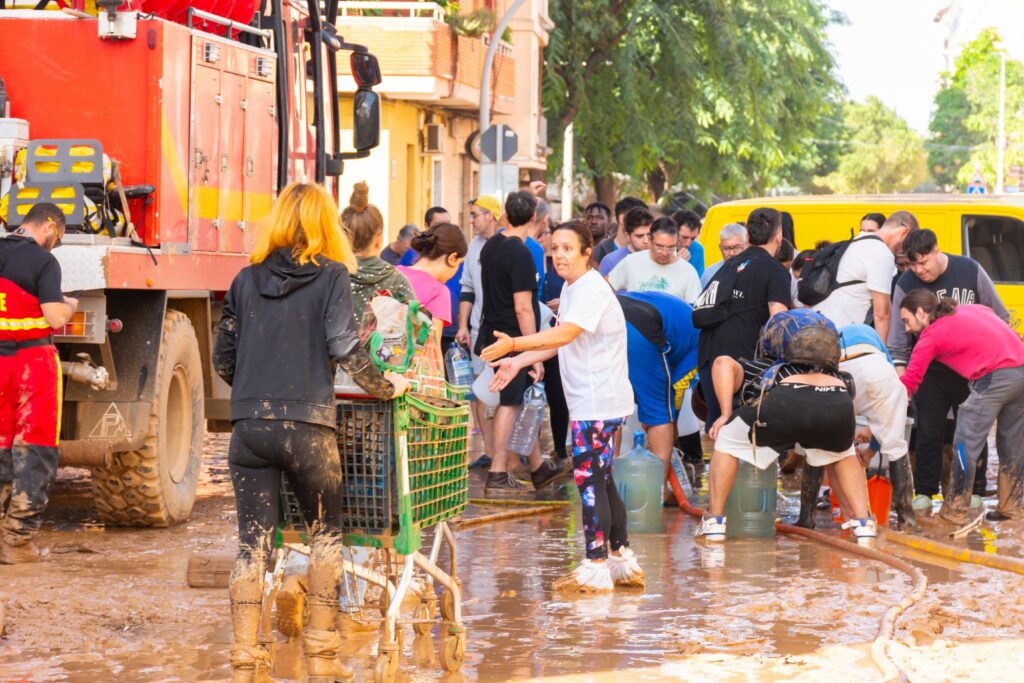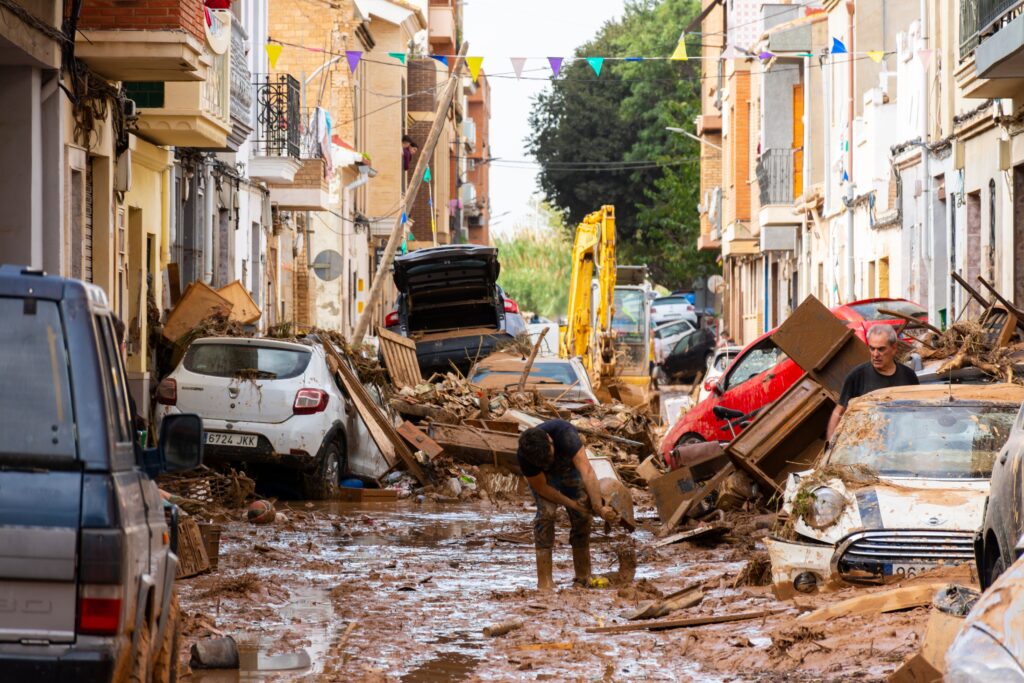This is the first article in a three-part column series by journalist Zoë Casey on ‘Europe’s Waters’. Guided by key findings of the 2024 Europe’s state of water report, this series delves into the intersection of climate change and Europe’s growing water crisis. As climate change intensifies, the world is grappling with increasingly extreme weather patterns, and transformations in the global water cycle are at the centre of these patterns. In 2024, over 111 countries experienced the hottest year on record, underscoring a proven reality: global warming is contributing to the intensification of extreme weather events, including floods, monsoons, and droughts. At the same time, the role of climate change in exacerbating weather extremes is only part of the story. Over centuries, drastic changes to landscapes and ecosystems have heightened the risk of exposure to pollutants and compromised our preparedness for these intensifying crises.
“Everything that could go wrong, went wrong”
School children across the world learn about the water cycle – a self-sustaining, continual circle that brings us rains, fresh water, flowing rivers and thriving seas, nourishing life on Earth. But what happens when this breaks down or becomes super-charged?
In October, a super-charged water cycle wrought destruction in Valencia, Spain. Roads turned into killer rivers: people living in ground level apartments could not open their front doors to escape, others were caught by violent waters while trying to save their cars from flooded underground garages. More than 200 people died, and many more lost their livelihoods as the mud-laden flash floods smashed into homes, land, infrastructure and businesses.
Floods have impacted humans for better or for worse through-out history, but global heating is making them more frequent and more intense. The weather conditions experienced in Valencia this October are now twice as likely to occur and 12% more intense than just a few years ago, says Ana Moreno, an expert at the Department of Geoenvironmental Processes and Global Change at the Spanish National Research Council.
Hot Mediterranean waters fueled the rains
This summer, parts of the Mediterranean Sea reached a record 28.9°C. By autumn, the sea was still warm, intensifying evaporation and swelling the amount of water in the air. When this saturated air rose, forced up by the mountains surrounding Valencia, it met a layer of cold polar air – known as a “Gota Fria” – higher up in the atmosphere, condensed and literally poured from the skies onto the hard surfaces below. The roads, compacted farmland soils and solid urban surfaces were not capable of absorbing this deluge, so it collected and became a force of shocking devastation within hours.
“Local people are used to flooding, that’s why they were getting their cars out of garages, but nobody expected the scale of death and destruction. The same amount of rain that falls over a one-and-a-half-year period in the region fell within just 24 hours,” said Eva Hernández Herrero, coordinator of the Living European Rivers initiative for nature conservation organisation WWF.
And yet, we should not be surprised by what happened given the findings of the European Environment Agency’s “Europe’s State of Water 2024” report. Published just days before the floods, the report contains multiple warnings about extreme floods, droughts and – crucially – Europe’s lack of preparedness.
The report also chronicles recent disasters: “Within a few months in 2023, there were severe floods with loss of life in Italy, Norway, Slovenia and along the Mediterranean coast.” It goes on to warn: “Unless major changes occur in European lifestyles and economic development, Europe’s water resources and ecosystems will continue to deteriorate, accelerated by the intensification of climate change impacts.”

Why the Valencia floods hit so hard
“Everything that could go wrong, went wrong,” said Hernández referring to the climate change-driven warmer Mediterranean waters, the cold layer of air in the upper atmosphere, and the mountains surrounding Valencia which, together, created the catastrophic conditions.
Climate change alone, however, does not explain the ferocity of the floods. Over recent centuries, urbanisation and increasingly intensive agriculture have turned natural areas in the region into hard, impermeable surfaces. The city’s famous Albufera wetland has shrunk from an estimated 30,000 hectares in Roman times to just 3,000 hectares today. This once natural area has been engineered for rice paddies and then largely drained for urban development. During a construction frenzy from the 1990s until 2008, one in ten houses affected by the floods were built in the flood risk zone, according to DATADISTA statistics.
“Homes and businesses are too close to the rivers, temporary streams have been strangled by development, rivers have been dredged, straightened and “cleaned” of vegetation, while upstream soils are eroded and weak meaning they loaded the flood water with mud making the force even more powerful,” explains Hernández. “The thinking used to be that water flows should be sped-up during times of heavy rain so they reach the sea quicker – this may have worked in previous decades, but climate change means we need to seriously rethink this approach,” she adds.
Fake news: pointing the finger at dam removals
As local people debate why the floods were so bad and why so many died, some in the online community have found a scape-goat: “One of the most upsetting things that happened following the devastation, was to see how some people started spreading misinformation about dam removal being the cause of the floods when this was a total lie,” says Hernández.
“The truth is, as far as we know, since 2000 no dams have been removed. In the area affected by floods, only small weirs under two metres high have been dismantled since their permits expired and there was no reason to keep them there – they’re too low for flood protection anyway,” she adds.
Call for both engineering and nature-based solutions
Hernández supports ideas like adapting bridges to deal with raging flood waters, adding internal staircases in apartments that would allow ground-floor residents to escape to higher levels, removing some houses in very high-risk areas and incentivising residents with outside spaces to make them permeable rather than paved-over. “After floods which happened south of Valencia in 2019, some houses were removed near to the river – now this area is a park which floods safely when the water needs somewhere to go – this could be replicated,” she says.
She also encourages making more room for rivers to expand naturally upstream before they reach populated areas, and allowing them to snake and meander to slow the current, rather than speed it up. River restoration projects that reintroduce curves, re-vegetate river banks and return flood plains to nature would offer flood defences, benefit ecosystems and provide more effective protection against the effects of drought as healthy soils are capable of storing water naturally.
Alfredo Ollero Ojeda, Professor of Physical Geography at the University of Zaragoza, is also recommending ways in which Valencia can better prepare for climate crises. He supports the creation of a ‘rapid alert protocol’ to avoid deaths in the future, the introduction of a ban on new construction in floodable zones and the development of a risk management plan that incorporates input from experts in geography, biology, environmental sciences, sociology, psychology, engineering and architecture. He would also welcome a ban on the construction of any new canals that would speed up the velocity of the water current, and he backs leaving river vegetation in place that can temper the flow of water.
Political will to act on climate change is ebbing
Valencia has been in the spotlight recently, but water disasters are already a reality across Europe. Various attempts at EU-wide legislation have been made including the Water Framework Directive, Floods Directive and, more recently, the Nature Restoration Law which incorporates targets to restore land, seas, and free-flowing rivers. However, the current populist, far-right tide of European politics resulted in a watering down of the Nature Restoration Law in the European Parliament last year, and the new right-leaning European Commission is unlikely to support further green measures.
“Without any climate mitigation and adaptation, direct damage from flooding is estimated to increase six-fold from present losses by the end of the century,”
Climate change and the destruction of the natural world may no longer hold the power for policy change they did five years ago when the world paid attention to Greta Thunberg, but the economic argument for climate action might still persuade decision makers to act. The Europe’s State of Water 2024 report warns that the cost of water scarcity and flooding is rising. Drought and extreme temperatures in 2022 cost €40 billion, while the 2021 floods in Belgium, Germany and the Netherlands cost €44 billion, affecting the lives of low-income families particularly harshly. “Without any climate mitigation and adaptation, direct damage from flooding is estimated to increase six-fold from present losses by the end of the century,” the report warns starkly.
